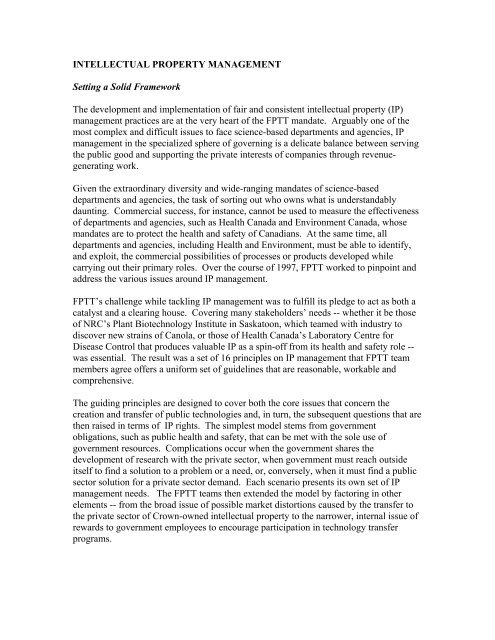FEDERAL PARTNERS IN TECHNOLOGY TRANSFER
FEDERAL PARTNERS IN TECHNOLOGY TRANSFER
FEDERAL PARTNERS IN TECHNOLOGY TRANSFER
Create successful ePaper yourself
Turn your PDF publications into a flip-book with our unique Google optimized e-Paper software.
<strong>IN</strong>TELLECTUAL PROPERTY MANAGEMENT<br />
Setting a Solid Framework<br />
The development and implementation of fair and consistent intellectual property (IP)<br />
management practices are at the very heart of the FPTT mandate. Arguably one of the<br />
most complex and difficult issues to face science-based departments and agencies, IP<br />
management in the specialized sphere of governing is a delicate balance between serving<br />
the public good and supporting the private interests of companies through revenuegenerating<br />
work.<br />
Given the extraordinary diversity and wide-ranging mandates of science-based<br />
departments and agencies, the task of sorting out who owns what is understandably<br />
daunting. Commercial success, for instance, cannot be used to measure the effectiveness<br />
of departments and agencies, such as Health Canada and Environment Canada, whose<br />
mandates are to protect the health and safety of Canadians. At the same time, all<br />
departments and agencies, including Health and Environment, must be able to identify,<br />
and exploit, the commercial possibilities of processes or products developed while<br />
carrying out their primary roles. Over the course of 1997, FPTT worked to pinpoint and<br />
address the various issues around IP management.<br />
FPTT’s challenge while tackling IP management was to fulfill its pledge to act as both a<br />
catalyst and a clearing house. Covering many stakeholders’ needs -- whether it be those<br />
of NRC’s Plant Biotechnology Institute in Saskatoon, which teamed with industry to<br />
discover new strains of Canola, or those of Health Canada’s Laboratory Centre for<br />
Disease Control that produces valuable IP as a spin-off from its health and safety role --<br />
was essential. The result was a set of 16 principles on IP management that FPTT team<br />
members agree offers a uniform set of guidelines that are reasonable, workable and<br />
comprehensive.<br />
The guiding principles are designed to cover both the core issues that concern the<br />
creation and transfer of public technologies and, in turn, the subsequent questions that are<br />
then raised in terms of IP rights. The simplest model stems from government<br />
obligations, such as public health and safety, that can be met with the sole use of<br />
government resources. Complications occur when the government shares the<br />
development of research with the private sector, when government must reach outside<br />
itself to find a solution to a problem or a need, or, conversely, when it must find a public<br />
sector solution for a private sector demand. Each scenario presents its own set of IP<br />
management needs. The FPTT teams then extended the model by factoring in other<br />
elements -- from the broad issue of possible market distortions caused by the transfer to<br />
the private sector of Crown-owned intellectual property to the narrower, internal issue of<br />
rewards to government employees to encourage participation in technology transfer<br />
programs.


